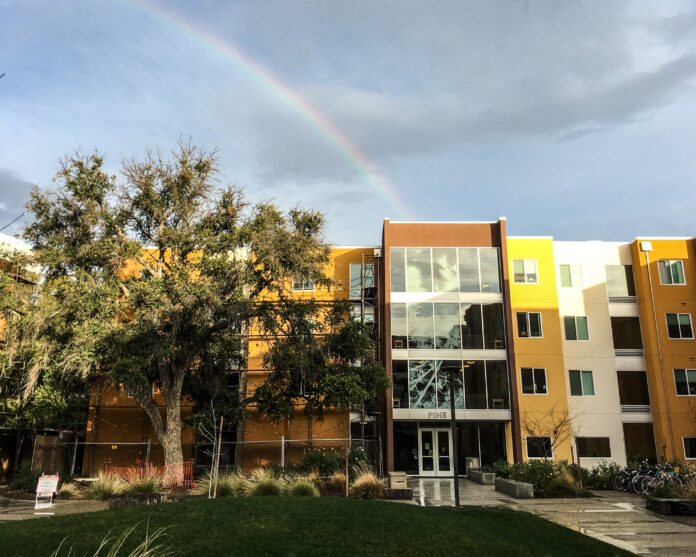Climate change and drought concerns persist despite record-breaking precipitation
By YAN YAN HUSTIS HAYES — city@theaggie.org
On Oct. 24, Sacramento received a total of 5.44 inches of rain. This marks the largest 24-hour precipitation in over 100 years, breaking the previous record established in 1880. The weekend of rain also provided the North Sierra half the amount of rain in just one weekend than the entire region has received over the entire last year.
While it is tempting to view the rainfall as a turning point in California’s ongoing drought emergency, it follows an extremely dry period beginning in 2019. Associate professor of climate change impacts, Erwan Monier, warned that we should not expect the rain to continue into the winter season.
“We expect these coming months/year to continue to be drier than usual—the 2019-2021 period has been extremely dry,” Monier said via email. “The recent precipitation is an anomaly and should not be seen as the beginning of a wet year.”
The rainfall on the weekend of Oct. 23 was an extreme event, but one that we should expect to see more of. With climate change, extreme events such as these will become increasingly common in the coming years, according to Monier.
“We don’t necessarily expect substantial changes in the total amount of annual precipitation in California, but we expect the rainy season to shorten, meaning we expect more intense precipitation when it falls,” Monier said via email. “Similarly, we expect a longer dry season, meaning Fall and Spring will experience less precipitation.”
In addition to more extreme floods and droughts, California should expect increased heat waves, major snowpack loss and increases in wildfire severity. Climate change has created conditions in which environmental events tend to become more extreme, according to Monier.
“Essentially, we expect increases in both flooding and droughts, however counterintuitive it may be,” Monier said via email. “Think: when it rains it pours, and when it’s dry it’s extremely dry. Climate change has been and will continue to intensify these two extremes.”
Fifth year computer science major Stephanie Do was glad for the rain after the dry conditions of the past years, but also noted how quickly the rain subsided.
“I definitely think the rain is super good because of this drought we’ve been having,” Do said. “It’s so weird because Sunday was so rainy, but then it was normal the next days.”
With an increase in wildfires, drought conditions and record breaking heat waves to name just a few extreme events, the past three years have been especially difficult and unpredictable. Do explained that the coronavirus pandemic changed her outlook.
“It’s crazy because you obviously never know what’s going to be next,” Do said. “With everything that’s happened, the most pressing issue is COVID. That has really messed up my perspective.”
In addition to her concerns about the drought, Do explained that the wildfires are also a primary issue.
“I feel like all of my social media there’s been at least one person who’s been affected by the fires,” Do said. “The past couple of years we’ve seen how climate change has affected our experiences especially with the fire[s].”
Like Monier, faculty professor and cooperative extension specialist in water resources, Samuel Sandoval Solis, stressed that the recent rain does not mean the end of California’s water problems.
“This rain is not breaking the drought,” Sandoval Solis said. “It is a good start and it replenished the deficit in moisture in Northern California but we are by no means in a position to replenish two years of below normal conditions.”
Sandoval Solis emphasized that fighting climate change and mitigating its effects are not easy fixes.
“Modifying legislation and making a change takes time, takes time for us to figure out how to take showers, it takes effort and a change of mindset,” Sandoval Solis said. “We need to start thinking about how to cut down our water use”
It is important that individuals recognize the small ways in which they can use water smarter, rather than looking to the rainy season to alleviate the stress from California’s drought. Sandoval Solis encouraged people to try and reduce their carbon footprint as best they can.
“Support local agriculture by buy[ing] local,” Sandoval Solis said. “Take shorter showers, use the dishwasher and maintain drought resistant landscapes. Your decisions will make a difference.”
The changing and increasingly extreme weather conditions that are worsened by climate change are not natural nor are they unique to California. Sandoval Solis explained that because of this it is important that we all do our part to combat climate change
“These [extreme weather] events happen once in a lifetime, not once in a decade,” Sandoval Solis said. “It is not normal. We easily forget that we’re in a drought, but no one can pull out.”
Written by: Yan Yan Hustis Hayes — city@theaggie.org



